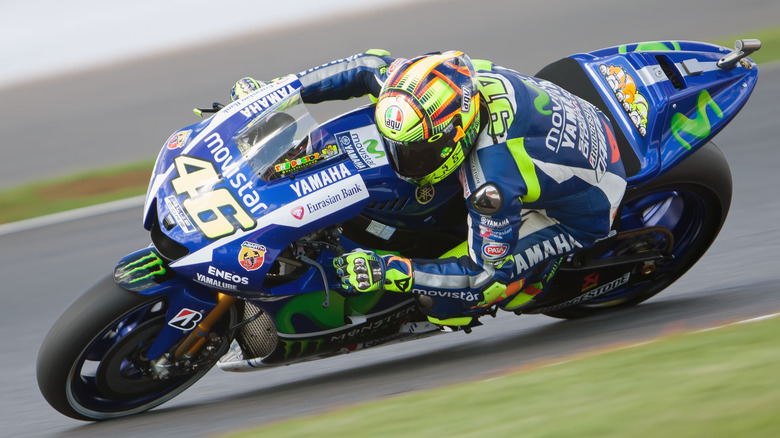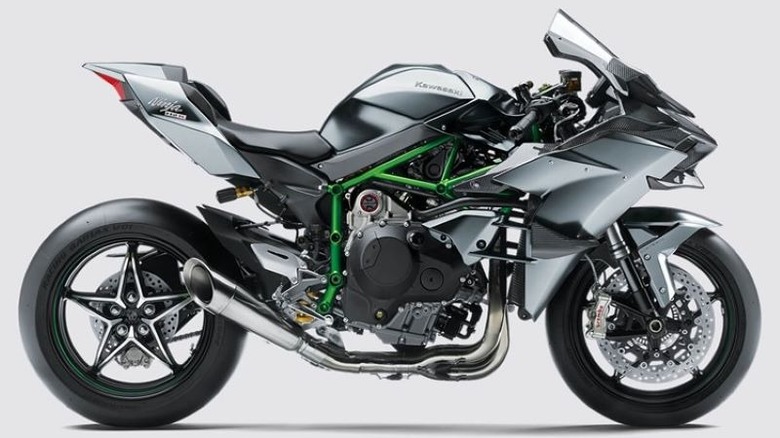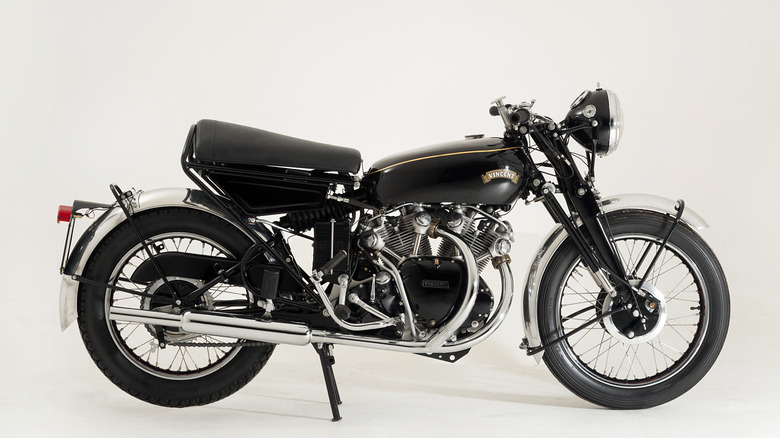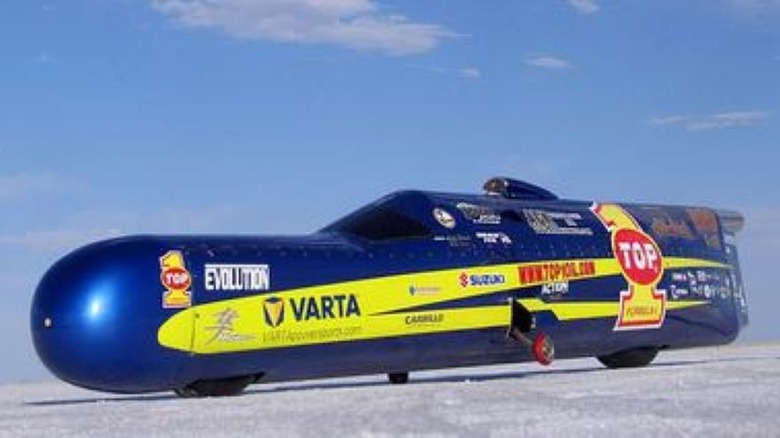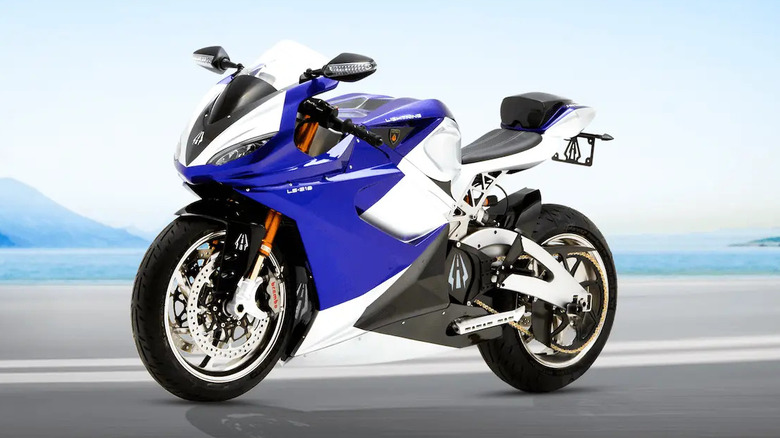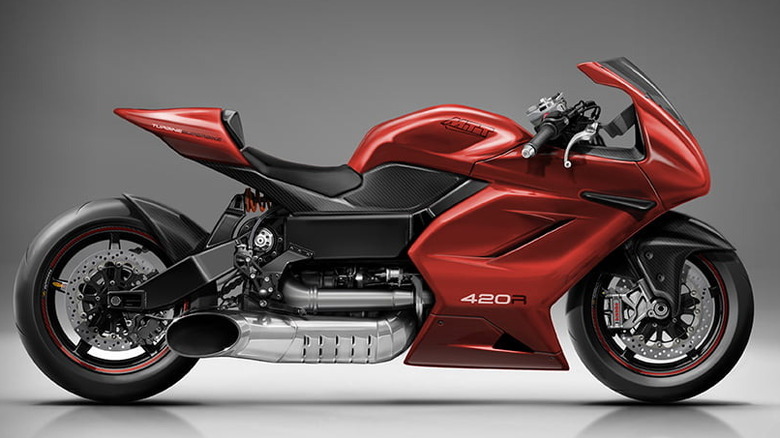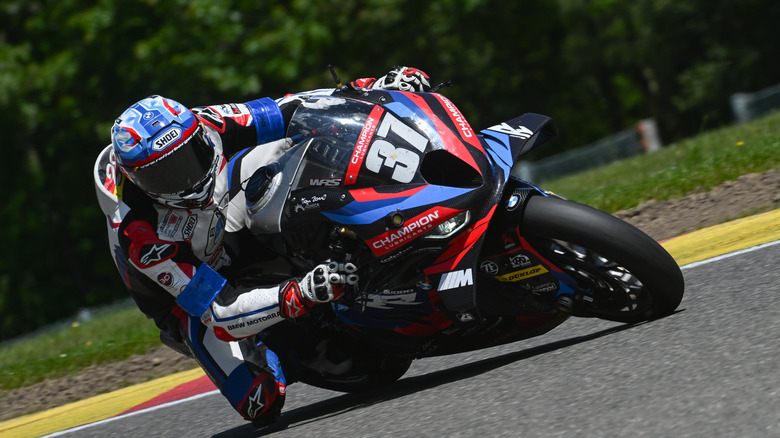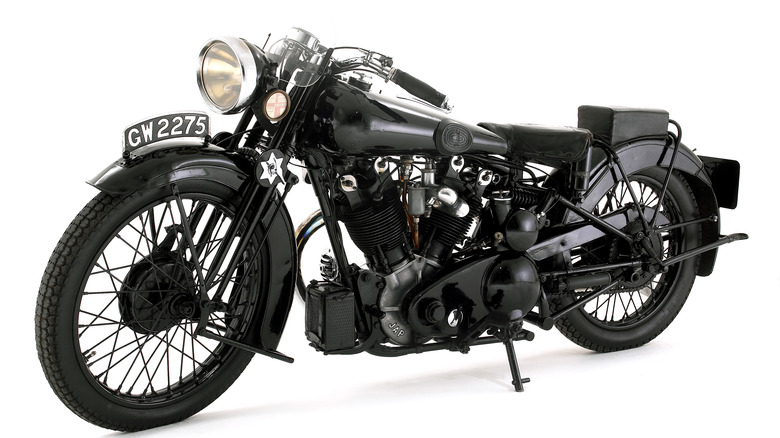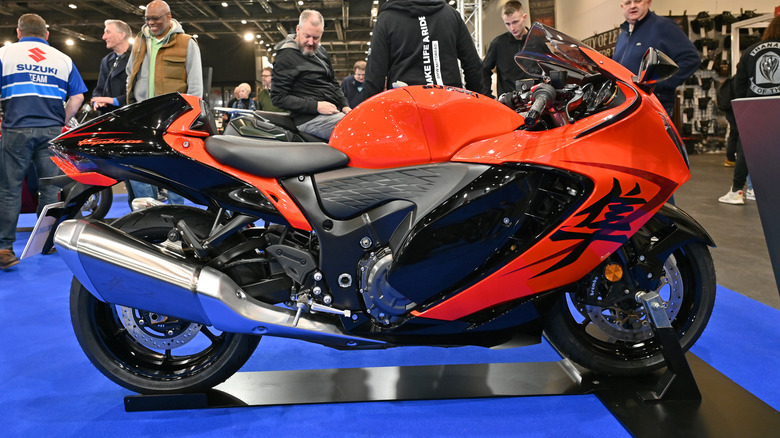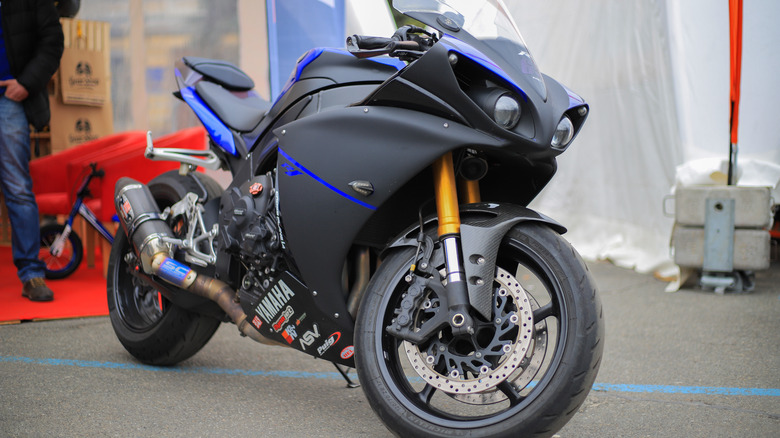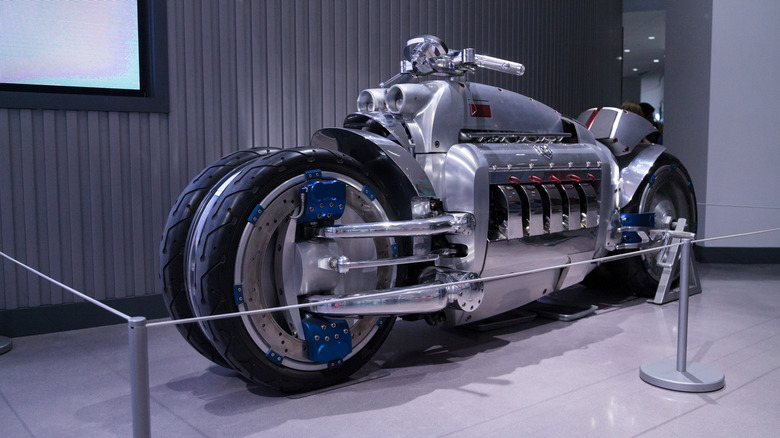10 Motorcycles That Once Held The Title Of Fastest In The World
Humanity's obsession with speed long predates the development of the automobile. Who can get to that tree first? How fast can I cover this field on foot? Fortunes have been won and lost betting all kinds of races. How fast will that car go? Just what velocity does it take to shatter gravity and stare into the eye of the universe?
Motorcycles are fast in many ways, and there are several ways to measure speed. Popular metrics include 0 to 60 miles per hour (mph) or 0 to 100 kilometers per hour (kph) stop-start, rolling start, lap time around a track, quarter-mile drags, and plain, old-fashioned top speed. Manufacturers advertise based on the speed at which a vehicle stops.
Which bikes qualify to hold the title of fastest in the world? Street-legal bikes differ wildly from land-speed record teams, which resemble top-tier racing units with space-age technology. The fastest car in the world has to be driven by a fighter pilot.
Here's a look at some motorcycles that once qualified as the fastest in the world in some way, from overall top land-speed record holders to best-in-class commercially available motorcycles. We've already told some stories about the fastest cars in the world and the drivers and engineers that made them possible. Come along as we dive into the history of humanity's second favorite conveyance: the mighty motorcycle.
Kawasaki Ninja H2R -- Production Top Speed Holder
There is a lot of supersport scuttlebutt, but have you ever heard of hypersport? That is how Kawasaki views its flagship Ninja H2R, and so too should the rest of us. Kawasaki deserves all the credit with this machine. It is not a repurposed ZX-10R, but a machine all its own.
For decades, Honda, Suzuki, Kawasaki, and Yamaha have clamored and competed for the top-speed motorcycle prize. Once held by Honda's Blackbird, it was unseated by the Suzuki Hayabusa, which perched upon the throne for years before Kawasaki came gunning for the title.
Kawasaki did not mess around. The corporation behind generations of Kawasaki motorcycles aimed to build the next fastest bike in the world from the ground up. Kawasaki required "technical elements not used in conventional motorcycle development," and technologies including "superchargers and supercharged engines."
The project ultimately birthed the Kawasaki Ninja H2R. The engine is a 998 cubic centimeter (cc) in-line four-cylinder. This is typical literbike language, but that doesn't usually include the word supercharger. Kawasaki reached deep into its corporate bag of goodies and pulled out its Gas & Turbine division to build a tailor-made blower.
The bottom line on the H2R is that it has every performance upgrade imaginable, and it is currently the reigning champion of speed amongst the big four. It has been recorded in the range of 250 mph (400 kph), and it doesn't look like any challengers are stepping up soon.
Vincent Black Shadow -- Production Top Speed Holder
The Vincent Black Shadow emerges from the heydey of British motorcycling. British Phil Vincent and Australian Phil Irving went into business together. Vincent purchased a factory with an inheritance. Phil was an engineer and writer. Together, they developed the Vincent HRD, also known as the Rapide, released in 1936.
The Rapide was commercially available and immediately a hit for its superior engineering. It was a reliable, quick, and popular motorcycle. Its successes allowed Vincent to upgrade it to something special.
The Black Shadow was released in 1948. It arrived with an air-cooled 998 cc V-twin engine. It was a superbike before there were superbikes. As beautiful as it was quick, the Black Shadow craned necks at any speed. Beneath its classic facade lurked upgraded suspensions and brakes. Vincent applied innovation and the latest technology. It could hit 125 mph out of the box, and the company boasted it was the world's fastest standard motorcycle. Naturally, a slew of riders and mechanics wanted to find out.
Rollie Free was the one who did. A racer from the 1920s and 1930s, he set a one-mile speed record of 150.313 mph (241.905 kph) on the Bonneville Salt Flats by lying down on the motorcycle wearing a swimsuit to reduce wind resistance. Who needs modern aero, anyway?
The Vincent Black Shadow was officially the fastest in the world. That speed might seem quaint by today's standards, but there was no faster motorcycle to purchase in 1948.
Ack Attack – Land Speed Record Holder
This is why we need separate categories. How can one compare the fastest production bikes with the Ack Attack? It doesn't even look like a motorcycle. It has a cockpit, for heaven's sake. Rest assured, it qualifies as a motorcycle. Only two wheels touch the ground, see?
Let's get it out of the way. The current top land speed record is 394 mph (634 kph). Rider Rocky Robinson set it in Ack Attack in September 2010, breaking a record held for 16 years. But how? A peek under the body (fuselage?) reveals a pair of Suzuki Hayabusa engines equipped with a serious turbocharger. Mated to what appears to be a missile, any layman could surmise that this thing moves. The turbo adds 30 PSI to the equation, so the sum is between 700 and 900 horsepower. A good set of tires and a deep breath, and suddenly, you're a world record holder. Anyone could do it. It's just a straight line. Except it's not.
Driver Rocky "Rocket Man" Robinson is a land speed race veteran, but what do you expect when naming your kid Rocket Man? It takes more than guts and a twisty right hand to keep a machine like this safe at those incredible speeds.
[Featured image Fair Use via Wikipedia | Cropped and scaled | Fair Use]
Lightning LS-218 -- Fastest E-Bike
The future is here, and there is no reasonable discussion of speed without an electric motorcycle in the fray. The Lightning LS-218 is powered by electricity. A 380 volt (V) 15 kilowatt/hour (kWh) battery pack gives the LS-218 a 188-mile (302 kilometers) range, but that's not the headline.
The real news is that the Lightning packs a 180+ kilowatt (kW) motor that makes 244 horsepower and 220 ft/lb of torque. That is an insane amount of power in a motorcycle that weighs 495 lbs (224 kg). The conventional technical specs read like a who's-who of aftermarket race products: Ohlins suspension and huge dual Brembo 4-piston calipers up front.
It looks like what the Blue Ranger rides to the Zord hangar on his off days. The LS-218 carries the menace of Yamaha's YZF-R1 with some Italian curves that would fit perfectly in a near-future epic film.
Lightning calls the LS-218 its first Superbike, and it has lived up to every ambition. Owner of multiple land-speed records, winner at Le Mans, beat the internal combustion engine (ICE) crowd at Pike's Peak. The company trumpets the gas-saving attributes of solid range and electric power, but this motorcycle is not meant for that. The LS-218 garnered not only winner's trophies, but was also the first electric bike to break the 200 mph (322 kph) mark in 2011. It would go on to raise the bar, setting the land-speed record for e-bikes at Bonneville with a 218 mph (351 kph) run.
MTT 420-RR -- Fastest Turbine
At first glance, it looks like a stretched Hayabusa, but that impression does not last long. It is the Marine Turbine Technologies (MTT) 420-RR. Remember when Kawasaki turned to the gas and turbine guys for the H2R supercharger? MTT CEO Ted McIntyre II is the gas and turbine guy. Based in southern Louisiana, MTT didn't build a motorcycle; they strapped one to a turbine.
The MTT gang claims an impressive 273 mph (439 kph) run on the turbine-powered bike, but motorcycles were not the starting point. MTT powered high-performance boats before building a Y2K Superbike. The earliest models received a Rolls-Royce Allison gas turbine. Since then, the MTT 420-RR has remained a turbine terror, garnering attention as part of Jay Leno's impressive auto collection.
The turbine reportedly makes about 420 horsepower and 500 lb/ft of torque running through a two-speed transmission. Details are sparse, and the claimed top speed has not been verified according to our research, but not a single eyebrow would raise if it showed up in a video hitting that speed.
BMW M1000RR – Fastest in Superbike right now –
Automotive fans know that BMW's M badge is a mark on the shoulder from the queen. M-series vehicles with the BMW insignia ought to be taken seriously. Take that same principle and filter it through FIM World Superbike regulations, add a century of production and racing experience, and you end up with the BMW M1000RR.
Lap times are a valid measure of speed. Carving a lap into a track and finding out who can do it when the knees drag might not break land-speed records, but speed through the corners is a lot of fun and just as important.
The 2024 has a base MSRP of $33,345, but the loaded $39,345 MSRP has all the bells and whistles. This bike is so high-tech that BMW files its engine specs and power numbers under "Data & Equipment." The M1000RR might represent a perfect blend of the automotive and technology realms.
Beemer ditches the boxers for once in favor of an in-line four-cylinder 999 cc rated for 205 horsepower. The M1000RR consistently rides near the front of the pack at the FIM Superbike World Championship. BMW Motorrad factory rider Toprak Razgatlioglu achieved 13 consecutive victories on this bad boy in the summer of 2024.
1929 Brough Superior SS100 – Fastest in the 1920s
England has a beautiful tradition of independent builders. Tinkerers, dreamers, and mechanics could build a small business from the right motorcycle. The Brough Superior SS100 comes from this tradition but does not extend it. Marketed as the "Rolls-Royce of Motorcycles" in all earnestness, the Super Sport 100 spent some time as the fastest motorcycle of the 1920s.
Pulling premium building materials from different suppliers, George Brough built the Super SS100 to custom specifications. In his spare time, he researched and developed by seeing how fast the darn thing could go. Brough's friend T.E. Lawrence (Lawrence of Arabia) owned one of the first 100 SS models until he died in an accident while riding it.
The Superior was guaranteed to reach 100 mph (161 kph). It had a 980 cc V-twin engine that made 74 horsepower until 1936 when Brough swapped it for a 45 horsepower 990 cc engine. The Alpine Grand Sport model was the pinnacle of the Brough Superiors. Eight were sold, one of them to Lawrence, who crashed it.
Brough Superiors are in high demand in the motorcycle market. A pristine edition will fetch a penny as pretty as the bike itself. A recent auction clapped the gavel on a 1929 Alpine Grand Sport for about $400,000. George Brough had broken the top speed record the previous year with a 130.6 mph (210 kph) run on a 1928 model.
Suzuki Hayabusa – Fastest Retiree
The champion may be out of power, but the Suzuki Hayabusa retains an honored place on Olympus. The Hayabusa was Suzuki's distinct effort to unseat the Honda Blackbird as the fastest production motorcycle in the world. Recently usurped by Kawasaki's insane H2R effort, it remains a formidable superbike of the highest tier.
The retiree headline is clickbait. Suzuki is nothing if not devoted to making the Hayabusa all it can be. This bike is far from retired. Packing a 1,340 cc engine and its distinctive alien warrior looks, the Hayabusa may be the second-fastest bike in the world, but it is not by much.
The Hayabusa has been around for 25 years, and the benefit is tons of blown-out bikes for people to salvage and build. As crazy as this sounds, the Busa is accessible — not to beginner riders, but to weekend warriors and race teams.
A souped-up Hayabusa just hit 274.962 mph (442.508 kph), beating a record set by Guy Martin. Not only is the Hayabusa still at the cutting edge of the speed race, it is far more accessible than something like Kawasaki's $58,000 H2R right now.
Yamaha YZF-R1 – Fastest around Nurburgring
The Nurburgring is viewed as an ultimate test for a reason, and the grueling 20-kilometer track hosts 24-hour road races for a reason. It is the measure against which dozens of new vehicles are tested each year. Achieving the top lap time around this legendary track is not a feat. And right now, that lap time belongs to Yamaha.
Yamaha has been building the R1 since 1998, updating it into a world-class representation of the literbike niche. While Honda, Kawasaki, and Suzuki jockeyed for top speed, Yamaha kept its great eye on the track. The upshot of which is the ultimate in consumer supersport track performance: the Yamaha YZF-R1.
In 2012, local hero Andy Carlile, who worked at Nurburgring, set a lap record of seven minutes and 10 seconds on a 2005 Yamaha R1. He beat the previous best by 20 seconds, cementing himself as a bona fide legend in the local racing community. Who doesn't want to own the record at the local track? That man won't have to buy a beer for the rest of his life.
The point is that the Yamaha R1 is still the pinnacle of motorcycles that produce literbikes. It might not be comfortable or have ABS or cruise control, but if it isn't fast around a track, nothing is.
Dodge Tomahawk – Fastest Concept Motorcycle
When Dodge wants to build a motorcycle, Dodge will do what it does best: slam V10 engines into borderline dangerous vehicles and call them performance (looking at you, Dodge Viper). So it was with the Tomahawk, a 2003 fever dream that saw one of the biggest auto producers on the planet build a four-wheeled vehicle and call it a motorcycle.
Logic and rationality aside, the Dodge Tomahawk is one insane motorcycle (if that's what it is.) Packed with a 500 horsepower 8.3-liter V10 stolen from the Viper, the quad-bike is strangely endearing. It looks almost like a Wall-E claptrap type cobbled together from spare parts, but it also looks like high art.
The monster weighed 1,500 pounds. It was a heavy motorcycle but a very light conveyance for that amount of power. No restraints whatsoever, but guess what? The thing was fast. It is an engine upon which one sits. It would be Anakin Skywalker's pod race if the pilots sat astride the engine. Hang on if you board this thing. Or don't. That's the scary thing about the Tomahawk — it doesn't care.
